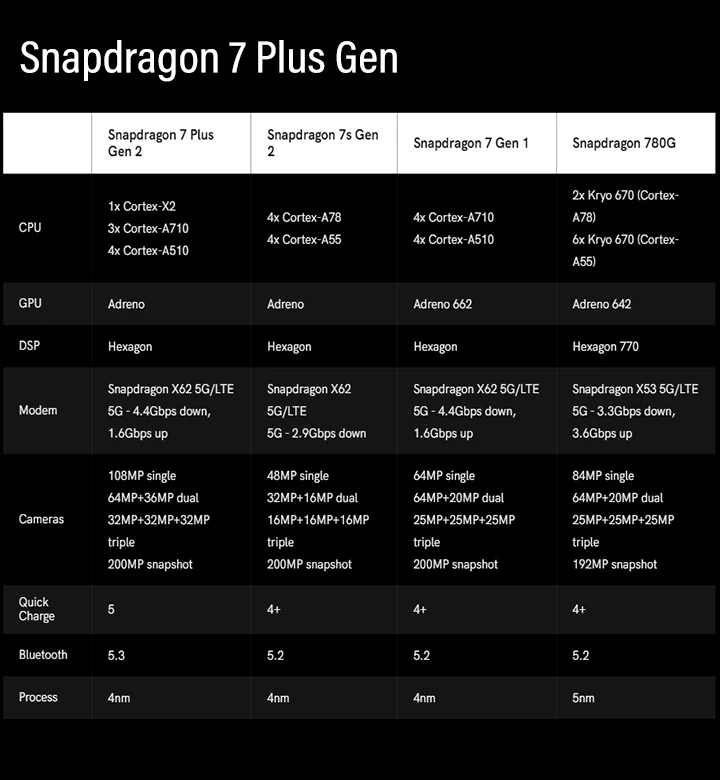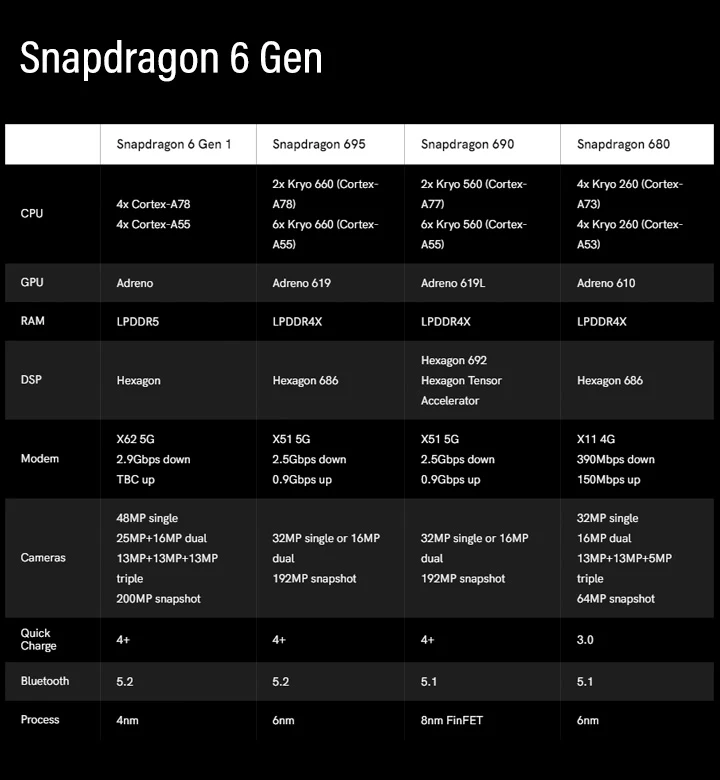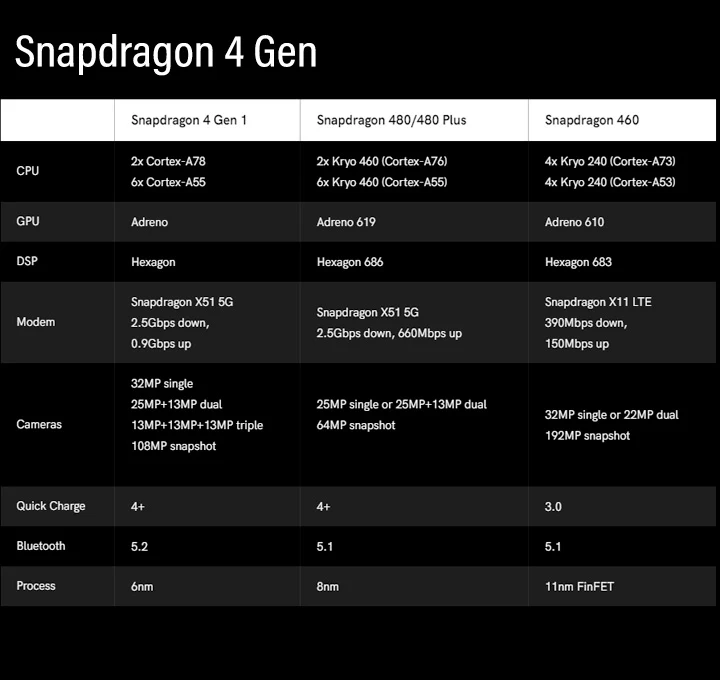Snapdragon processors from Qualcomm are some of the most widely used SoCs in Android smartphones. Although most flagship Android phones on the market are powered by Snapdragon CPUs, Samsung employs these chips for its Galaxy S range in different markets. The device you're using to read this is likely running a Qualcomm Snapdragon CPU.
However, Snapdragon CPUs aren't limited to pricey flagship devices. A wide range of processors designed for smartphones are available at different pricing points. Let's compare and explore the capabilities of the company's most recent SoCs. Performance and features vary significantly across various models.
 |
| Snapdragon SoC Guide |
Premium tier: Snapdragon 8 series
Are you trying to find the top Qualcomm CPU family for smartphones? The Snapdragon 8 range will be that. The most recent chip is the October 2023-announced Snapdragon 8 Gen 3. As of this writing, it is a brand-new release that is exclusive to the Xiaomi 14 series. However, a ton of flagship phones are anticipated to run on it by 2024.
Numerous improvements are brought about by the Snapdragon 8 Gen 3. It has an extremely potent CPU on paper, to start. One Cortex-X4 core, five Cortex-A720 cores, and two Cortex-A520 cores make up this 1+5+2 CPU. In actuality, Qualcomm claims that it is 20% more efficient and 30% faster than its predecessor.
Numerous improvements are brought about by the Snapdragon 8 Gen 3. It has an extremely potent CPU on paper, to start. One Cortex-X4 core, five Cortex-A720 cores, and two Cortex-A520 cores make up this 1+5+2 CPU. In actuality, Qualcomm claims that it is 20% more efficient and 30% faster than its predecessor.
The Snapdragon 8 Gen 3 is designed with on-device generative AI tasks as its primary focus.
This time around, Qualcomm is also fully committing to generative AI capabilities. It will provide text-to-image generation in less than a second, photo expansion (the ability to enlarge an image by using image generation), and support for sizable language models with more than 10 billion parameters operating at nearly 15 tokens per second. To put it simply, this is a powerful AI system.
Not to be overlooked are further enhancements such as a 25% faster and 25% more efficient Adreno GPU, support for global illumination graphics technology, video support for night mode, and the ability to delete objects from videos.
Not to be overlooked are further enhancements such as a 25% faster and 25% more efficient Adreno GPU, support for global illumination graphics technology, video support for night mode, and the ability to delete objects from videos.
 |
| Snapdragon Gen 3 |
The majority of 2023's top Android phones run on the Snapdragon 8 Gen 2, which is the forerunner to the Snapdragon 8 Gen 3. With its potent 1+4+3 CPU, excellent GPU, and numerous other improvements, it's still a beast.
Additionally, phones still use the Snapdragon 8 Gen 1 and 8 Plus Gen 1 CPUs from 2022. Many phones in the higher mid-range are equipped with the latter chip.
Snapdragon 8 series phones
- Samsung Galaxy S24 series
- Samsung Galaxy Z Flip 5
- Samsung Galaxy Z Fold 5
- OnePlus 11
- Xiaomi 13 series
- Xiaomi 14 series
- POCO F5 Pro
Bridging the gap: Snapdragon 7 series
The Snapdragon 7 series from Qualcomm is more complex than the company's flagship 8 series. This is because there are so many of them and because some older, lower-end CPUs are starting to compete with Snapdragon 6 models. Although the Snapdragon 7 Plus Gen 2 straddles the line between flagship and mid-range performance like no other chip before it, the Snapdragon 7 series was initially intended to be an upper mid-range family of processors.
This chipset, which was unveiled in early 2023, resembles a Snapdragon 8 Plus Gen 1 CPU above all others. The TSMC 4nm design, the CPU (one Cortex-X2, three Cortex-A710, four Cortex-A510), and the ISP appear to be on par with each other in terms of power. However, there are certain drawbacks, like the mid-tier Snapdragon X62 modem, a less spectacular but still strong GPU, and the absence of features like 8K recording.
The Snapdragon 7 Plus Gen 2 essentially mirrors the flagship silicon of 2022, with minor alterations and a GPU downgrade.
We also ran some benchmarks on a reference smartphone running the Snapdragon 7 Plus Gen 2, and the results showed that the chipset was able to match the CPU performance of the Snapdragon 8 Gen 1. In terms of GPU-related tests, there was still a noticeable performance difference, but it offered incredibly stable long-term performance. With the POCO F5, the first commercial phone to use this chip, the majority of these results were implemented in our time.
The Snapdragon 7 Gen 1 from 2022 was rather good, and it came before the Snapdragon 7 Plus Gen 2. This CPU configuration has eight cores total—four potent Cortex-A710 cores and four Cortex-A510 cores. According to Qualcomm, the new processor also improved machine learning performance by 30% and increased GPU power by 20% over the Snapdragon 778G. Support for 200MP cameras, 4K HDR recording, and a 4nm architecture are among the other noteworthy features. Sadly, not many phones using this chipset were ever released.
 |
| Snapdragon 7 Plus Gen |
In September 2023, Qualcomm also revealed the Snapdragon 7s Gen 2. This isn't a Snapdragon 7 Gen 1 sequel, despite what the name may suggest. Rather, this chip falls short of the 7 Gen 1. Although it still has a 4nm architecture and a powerful CPU (four Cortex-A78 and four Cortex-A55), this chip is behind in terms of connection and camera capabilities.
Another noteworthy chipset in this tier is the Snapdragon 780G from 2o21, which sports a triple-tiered CPU and a 5nm architecture. One 2.4GHz Cortex-A78 CPU, three 2.2GHz Cortex-A78 CPUs, and four Cortex-A55 CPU cores are what you're looking at. Additionally, the Adreno 642 GPU included with the Snapdragon 780G is supposed to provide performance comparable to that of previous flagships. Since Qualcomm's mid-range chips had historically lagged far behind older flagship processors, that was pretty noteworthy at the time.
Snapdragon 7 series phones
- HONOR 90
- POCO F5
- Motorola RAZR 2023
- Nothing Phone 1
Value for money: Snapdragon 6 series
The Snapdragon 6 series is primarily targeted at the ~$300 and lower category, whereas the Snapdragon 7 series attempts to close the gap between mid-range and flagship devices. And the Snapdragon 6 Gen 1 is the most noteworthy processor in this family.
The Snapdragon 6 Gen 1 is a major improvement over earlier Snapdragon 6 series SoCs, featuring an enhanced Adreno GPU and a potent CPU (4x Cortex-A78, 4x Cortex-A55). Indeed, Qualcomm asserts a 40% and 35% performance increase over the CPU and GPU of the Snapdragon 695, respectively. Additional noteworthy characteristics include the capability for 200MP snapshots, 4K video capture, and a 4nm architecture.
The Snapdragon 6 Gen 1 is a major improvement over earlier Snapdragon 6 series SoCs, featuring an enhanced Adreno GPU and a potent CPU (4x Cortex-A78, 4x Cortex-A55). Indeed, Qualcomm asserts a 40% and 35% performance increase over the CPU and GPU of the Snapdragon 695, respectively. Additional noteworthy characteristics include the capability for 200MP snapshots, 4K video capture, and a 4nm architecture.
 |
| Snapdragon 6 Gen |
The Snapdragon 695, which was a minor improvement above the Snapdragon 690 from 2020, was the previous top-end processor in this series. The 695 features an Adreno 619 GPU, similar to the Snapdragon 750G, and a powerful octa-core CPU (2x Cortex-A77 and 6x Cortex-A55). Wi-Fi 6 connectivity, 108MP single camera compatibility, and 13MP triple camera support are also included. But the absence of 4K video capture is the main letdown in this case.
Simultaneously with the 695, Qualcomm also released the Snapdragon 680, which differs from the previous chips in that it is a 4G-only SoC. With features like the Adreno 610 GPU, Hexagon 686 DSP, Quick Charge 3.0 quick charging, and outdated CPU cores (four Cortex-A73 and four Cortex-A53), it appears to be developed from the older, less expensive Snapdragon 665 SoC. However, there are a few improvements: Bluetooth 5.1 compatibility and a significantly smaller 6nm manufacturing technique.
Snapdragon 6 series phones
- Sony Xperia 10 IV
- OnePlus Nord N30
- POCO X4 Pro
- Redmi Note 11
- Samsung Galaxy A23
Entry-level: Snapdragon 4 series
Except for the dormant/shutdown Snapdragon 200 family, we now arrive at the least capable Snapdragon series, intended for low-cost phones. Nonetheless, there is excellent news because the most recent Snapdragon 4 chipset is a significant advancement.
With a 6nm design, a reasonably powerful CPU (2x Cortex-A78, 6x Cortex-A55), and a 10% faster GPU than the Snapdragon 480, the Snapdragon 4 Gen 1 is an improvement over its predecessor. Other than that, there are a lot of similarities between this SoC and the Snapdragon 695. We have the same X51 5G modem, Wi-Fi 5, 120Hz support at FHD+ display resolution, and comparable camera capabilities (no 4K recording here).
With a 6nm design, a reasonably powerful CPU (2x Cortex-A78, 6x Cortex-A55), and a 10% faster GPU than the Snapdragon 480, the Snapdragon 4 Gen 1 is an improvement over its predecessor. Other than that, there are a lot of similarities between this SoC and the Snapdragon 695. We have the same X51 5G modem, Wi-Fi 5, 120Hz support at FHD+ display resolution, and comparable camera capabilities (no 4K recording here).
The Snapdragon 4 series sacrifices powerful GPU and 4K recording capabilities in exchange for high refresh rate support and 5G connectivity.
Take a step back and meet the Snapdragon 480. When it was first unveiled in early 2021, this was the first Snapdragon 4 series chipset with 5G support. With support for FHD+ 120Hz displays, the same Adreno 619 GPU, the same 8nm manufacturing process, Quick Charge 4 Plus technology, and mmWave 5G connectivity, this is essentially a trimmed-down Snapdragon 750G processor.
 |
| Snapdragon 4 Gen |
There are a few limitations, too, like slower 5G speeds, less stunning camera capabilities (no 4K recording, support for 64MP snapshots), and older CPU cores (2x Cortex-A76 and 6x Cortex-A55). Even so, considering that the 4 series at the time lacked 5G capabilities and more contemporary CPUs, this was a significant upgrade.
The Snapdragon 480 Plus replaced the Snapdragon 480 in late 2021, but this is more of a slight improvement than a significant advancement.
Snapdragon 4 series phones
- Redmi Note 12 5G
- Motorola Moto G62
- OnePlus Nord N100
- Nokia XR21
That’s all for our Qualcomm Snapdragon SoC guide! Let us know your thoughts on the silicon giant’s portfolio in the comments.

This is exactly the kind of content I look for when I want to learn about tech.
ReplyDelete